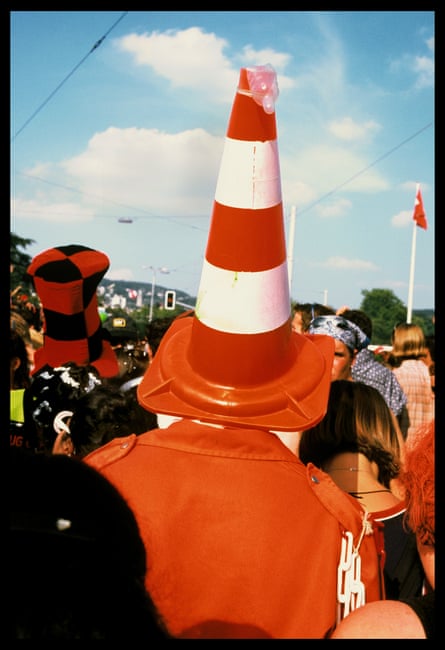Zurich was quick to embrace techno and, by the time the music reached its zenith in the 1990s, the city had become a prime destination for the genre in Europe. Techno parties began as one-time events in cellar and warehouse squats before expanding to become an established club scene with a programme of regular events.
The Swiss city’s techno scene was shaped by Street Parade, which was authorised in 1992 as a “demonstration of love freedom, generosity and tolerance”. Kicking off with fewer than 1,000 participants, they have grown steadily to attract 1 million visitors each year – three times the number of the city’s inhabitants.
The photographer Jules Spinatsch took pictures of individuals and small groups, often on the fringes of the fast-moving crowd, at the parades in the mid-90s.
Spinatsch says: “In the picture, the people were to regain their individuality, which had been dissolved in the crowd. Because even a lot of colourful people become grey as a mass from a distance. This isolation stops time, takes a section out of the flow of movement and creates air and distance from the action.”
The current installation of the photographer’s work as a multichannel slideshow is intended to feel like a parade of images and individuals.
“The pictures come from a time when many things were changing, and not just in Zurich. The cold war was over, dull Zurich had become a party city – more colourful, noisier, more international, denser. The Street Parade was an expression of this and had a political dimension.
“The [parades] called for peace and tolerance and propagated this with fun, hedonism and ease and non-ideologically, in contrast with today. But how much is protest and party; how much is activism or escape?
“I had a strong feeling of being part of something new. But at the same time I was no longer interested in taking pictures of demonstrations, not the crowd as a dancing ornament, not the power of the political movement in the picture. It was the people on the fringes of the event who embodied these ideas through their presence and their styling.
after newsletter promotion
“Often I would shoot at the exact moment the person saw the camera, but their facial expression was not yet reacting to me, to capture an unexpected, unsuspecting look, a look that would surprise me and those I was photographing.
“Now, almost 30 years later, it seems as if the people are looking questioningly from the pictures of the past into the future at us, the visitors to the exhibition, which we know and they do not yet. At the same time, we are looking back into this time, into the faces, as if we can make contact in order to answer their questions. In doing so, we make contact with our own past. Reconnect with your past.
“In the first year I made photographs, it felt like everyone present danced on or next to the lovemobiles. From 1996 to 1997 when the numbers of visitors jumped from 150,000 to 475,000, I perceived a crucial shift. The Street Parade has become a spectacle with onlookers watching lovemobiles passing, separating the participants into spectators and activists.
“This shift from politics to entertainment might have been a precondition for the Street Parade and Zurich techno culture’s inclusion as part of Unesco’s intangible cultural heritage. And in 2017, the Federal Office of Culture added it to the list of living traditions in Switzerland.
“One might ask to which Swiss tradition does it refer, that of the neutral bystander or the activist who takes part?

